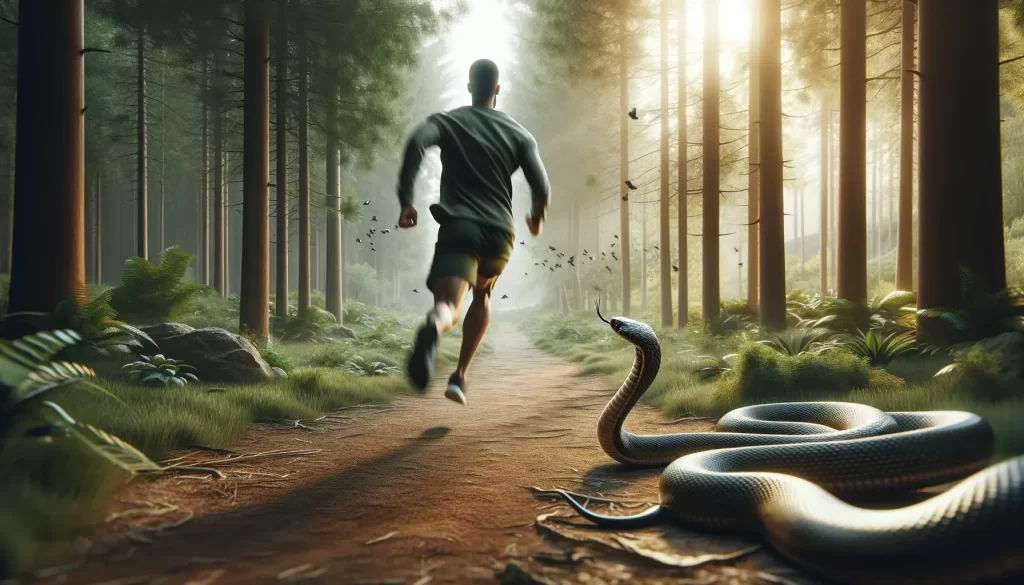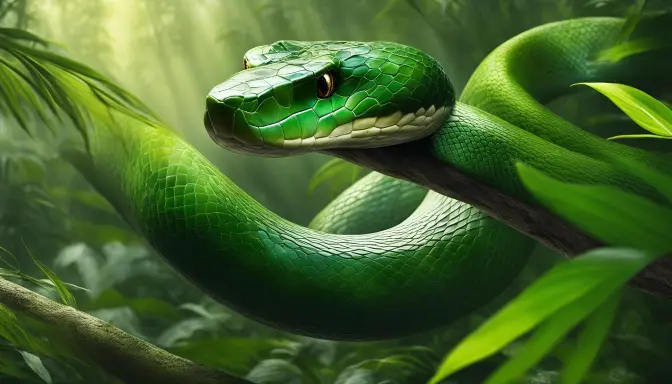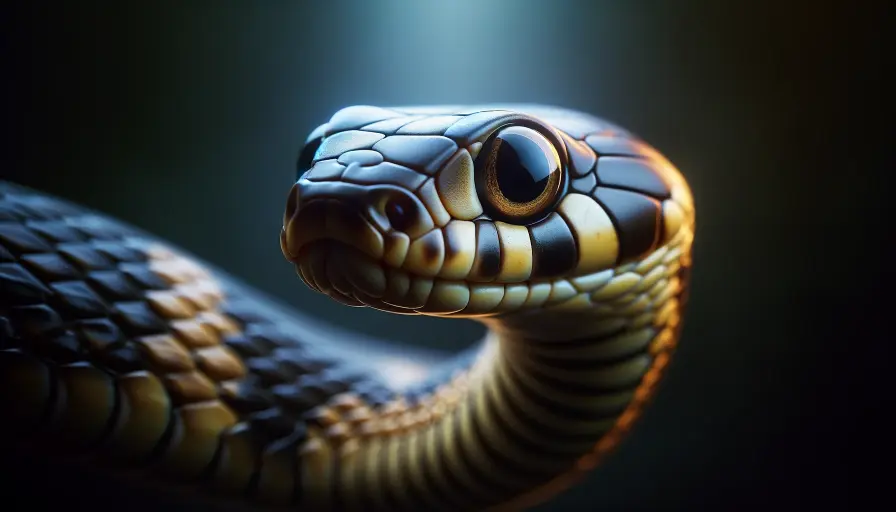
Snakes have always fascinated us with their slithering movements and mysterious behavior. When it comes to speed, we often assume that humans can easily outrun these legless creatures.
But is that really the case? In this article, we delve into the fascinating world of snake speed and explore the truth behind outrunning snakes.
When it comes to comparing the speed of snakes and humans, it’s clear that humans have the advantage. Snakes are generally not as fast as humans, with the fastest snake, the Black Mamba, only reaching speeds of around 12 miles (19.3 kilometers) per hour, which is comparable to an average walking speed.
Key Takeaways:
- ✅ Snakes may not be the fastest creatures, but they possess cognitive abilities that were previously underestimated.
- ✅ The speed of snakes varies depending on the species, but in general, humans can outrun them in a straight line.
- ✅ Debunking the myth, lying flat on the ground might not be the best strategy when facing an anaconda; running uphill could be more effective.
- ✅ Snakes are adaptable creatures, capable of learning and navigating unfamiliar environments.
- ✅ Contrary to popular belief, snakes rely on vision as well as chemical cues.
The Speed of Snakes Compared to Humans
While this may not seem impressive, it’s important to consider the fact that snakes have their own unique hunting strategies that rely more on stealth and surprise rather than outright speed.
Snakes are ambush predators and use their ability to camouflage and strike from hidden positions to capture prey.
Their bodies are well adapted for this type of hunting, with long and slender forms that allow them to move swiftly and undetected.
Snakes also possess incredible agility, capable of maneuvering through tight spaces and navigating challenging terrains.
However, in a straight line, humans have the ability to outrun snakes. Our upright posture and bipedal locomotion give us the advantage when it comes to speed and endurance.
So if you find yourself in a situation where you need to flee from a snake, running in a straight line will likely lead to your escape.
The Importance of Adaptation
While snakes may not be able to beat humans in a race, they are incredibly adaptable creatures. Their ability to navigate mazes and learn their way through unfamiliar environments, as shown in David Holtzman’s research with corn snakes, demonstrates their cognitive abilities and problem-solving skills.
Snakes rely on visual and tactile cues to find their way around, and younger snakes are especially resourceful and adaptable.
- Despite their reputation as slow-moving creatures, snakes are surprisingly agile and well-adapted for their hunting strategies.
. - Humans have the advantage when it comes to speed and can outrun snakes in a straight line.
. - Snakes possess cognitive abilities and can learn and navigate through mazes, showcasing their adaptability.
In the next section, we will debunk the myth surrounding anacondas and their chasing abilities, providing further insight into the running capabilities of snakes.
Debunking the Anaconda Myth

One common myth that has circulated for years is the idea that humans cannot outrun an anaconda.
According to this myth, if you find yourself being chased by an anaconda, your best course of action is to lie flat on the ground in the hope that the snake will lose interest.
However, experts, such as Don Boyer, a herpetologist, have debunked this myth and shed light on the true abilities of these powerful reptiles.
Anacondas are undeniably large and formidable snakes, but in terms of speed, they are not particularly fast runners.
Their preferred hunting method is through stealth and ambush, rather than chasing down their prey.
Anacondas are known to lie in wait, camouflaged in their surroundings, waiting for the perfect moment to strike.
While it is highly unlikely for a person to find themselves in a chase with an anaconda, it is important to understand the best course of action if such a situation were to occur.
Contrary to the myth, lying flat on the ground would not be the most effective response. Running straight up a hill would be more advantageous, as it would make it more difficult for the snake to follow and catch up.
Snake Running Abilities
- Anacondas are not particularly fast runners compared to their size
- They rely on stealth and ambush to capture their prey
- In the unlikely event of being chased by an anaconda, running uphill is more effective than lying flat on the ground
By dispelling the myth surrounding anacondas’ running abilities, we can gain a better understanding of these remarkable creatures and appreciate their adaptations as apex predators in their natural habitats.
The Adaptability of Snakes

Snakes, often thought of as slow-moving creatures, possess a surprising level of adaptability. Recent research conducted by neuroscientist and herpetologist David Holtzman has shed light on the cognitive abilities of snakes, challenging the notion that they are strictly “lower” animals.
In his experiments with corn snakes, Holtzman found that these reptiles were able to learn and navigate mazes.
This highlights their ability to adapt to unfamiliar environments and utilize visual and tactile cues to find their way out.
Younger snakes, in particular, displayed a higher level of adaptability and resourcefulness.
Despite their adaptability, it’s important to note that snakes are generally not as fast as humans when it comes to running speed.
A snakes speed can vary depending on the species. Snakes are ambush predators, relying on stealth and surprise to capture their prey, rather than relying solely on speed.
The Adaptability of Younger Snakes
Younger snakes, being more adaptable, tend to rely more heavily on visual and tactile cues to navigate their surroundings.
They are more open to learning and exploring new environments, which allows them to adapt and find their way more effectively.
Older snakes, on the other hand, may rely more on visual cues and familiarity with their environment, as their ability to learn and adapt may decline with age.
- Younger snakes display a higher level of adaptability.
- They rely more heavily on visual and tactile cues.
- Older snakes may rely more on visual cues and familiarity.
In conclusion, while snakes may not be the fastest creatures, their adaptability and cognitive abilities are fascinating.
They are capable of learning and navigating mazes, using visual and tactile cues to find their way.
Understanding their adaptability and how they utilize their senses can lead to a greater appreciation for these unique creatures.
Understanding Snakes’ Visual Abilities

When it comes to snakes, many people assume that their primary sense is smell and that they rely on chemical cues to navigate their surroundings.
However, recent research has shed light on the visual abilities of snakes, challenging this assumption.
Neuroscientist and herpetologist David Holtzman conducted experiments with corn snakes in an arena, where he observed their remarkable use of visual cues.
Holtzman’s experiments involved using colored cards to mark the exit hole in the arena, and the snakes successfully navigated towards the marked locations.
This suggests that snakes have the capability to use visual cues to locate places, disproving the notion that they solely rely on chemical cues.
These findings open up new avenues for understanding snakes’ perception of their environment and how they interact with it.
The Role of Vision in Snake Behavior
Snakes’ visual abilities have important implications for their hunting strategies and survival. While snakes are known for their stealthy approach and ambush tactics, their ability to use visual cues enhances their hunting efficiency.
By detecting and tracking visual stimuli, snakes can locate prey more effectively and adapt their hunting techniques accordingly.
Moreover, understanding snakes’ visual abilities is crucial for their conservation. Snake populations are facing numerous challenges, including habitat loss and fragmentation.
By recognizing and valuing the diverse sensory abilities of snakes, we can better appreciate and protect their unique role in ecosystems.
Enhancing Our Understanding of Snakes
Research on snakes’ visual abilities is expanding our knowledge of these fascinating creatures. By debunking the assumption that snakes rely solely on chemical cues, we gain a more comprehensive understanding of their behavior and cognitive capabilities.
We now recognize that snakes use visual cues to navigate their environment and locate specific places, demonstrating a level of adaptability and intelligence that was previously underestimated.
As we continue to explore the complex world of snakes, it is important to approach these investigations with an open mind and a willingness to challenge long-held beliefs.
By doing so, we can unravel the mysteries of snake behavior and further appreciate the remarkable diversity of the natural world that surrounds us.
Snakes’ Ecological Importance

Snakes, often misunderstood and met with fear, play a crucial role in maintaining the delicate balance of ecosystems.
While their reputation may precede them, it’s important to recognize the ecological importance of these fascinating creatures.
1. Natural Pest Control:
One of the key contributions of snakes is their role as natural pest control agents. Snakes help control populations of rodents and insects that can otherwise cause significant damage to crops, gardens, and homes.
By preying on rodents such as mice and rats, snakes help keep their numbers in check, reducing the negative impact they have on human activities.
2. Maintaining Biodiversity:
Snakes are an integral part of food chains and webs, occupying various niches in different ecosystems. Their presence ensures the balance and stability of these ecosystems by regulating the populations of their prey species. By preventing the overgrowth of certain species, snakes indirectly promote biodiversity and contribute to a healthy and functioning environment.
3. Indicator Species:
As sensitive creatures, snakes are highly affected by changes in their environment. Their presence or absence can serve as an indicator of the overall health of an ecosystem.
By monitoring snake populations and studying their behavior, scientists can gain valuable insights into the well-being of their habitats and the potential impact of human activities on these ecosystems.
Understanding and appreciating the ecological role of snakes is essential for their conservation and the preservation of biodiversity.
By promoting coexistence and dispelling common misconceptions about snakes, we can foster a greater respect for these remarkable creatures and ensure their vital contributions to our planet’s ecosystems.
Conclusion
In conclusion, snakes may not be the fastest creatures in terms of running speed, but they possess incredible cognitive abilities that continue to surprise us.
While humans can generally outrun snakes in a straight line, it’s important to recognize that snakes have their own unique hunting strategies that rely on stealth and surprise rather than sheer speed.
Debunking myths such as the belief that humans cannot outrun an anaconda and understanding the adaptability and visual capabilities of snakes allows us to appreciate these fascinating creatures even more.
Snakes play a crucial role in maintaining ecological balance by controlling populations of rodents and insects, acting as natural pest control.
So, while we may not need to worry about being outrun by a snake, it’s important to understand and respect their abilities.
By gaining a deeper appreciation for snakes and their place in the natural world, we can foster a greater understanding of the importance of biodiversity and conservation.
Frequently Asked Questions
Q: Can snakes outrun humans?
A: Snakes are generally not as fast as humans. While the fastest snake, the Black Mamba, can reach speeds comparable to an average walking speed, humans have the ability to outrun snakes in a straight line.
Q: Is it true that lying flat on the ground can protect you from an anaconda?
A: No, that is a common myth. While anacondas are large and powerful snakes, they are not particularly fast runners. If being chased by an anaconda, it is more effective to run straight up a hill than to lie flat on the ground.
Q: Do snakes use vision to navigate their surroundings?
A: Yes, snakes do use vision along with other cues to locate places. Recent research has shown that snakes, such as corn snakes, can use visual cues to find their way out of unfamiliar environments.
Q: Do snakes have any ecological importance?
A: Yes, snakes play a vital role in maintaining ecological balance. They help control populations of rodents and insects, serving as natural pest control.



